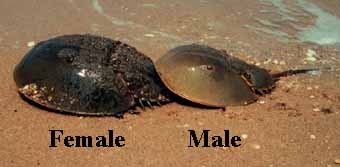
Observational studies on horseshoe crabs in the area of Cape Cod, MA, indicated that in the mating population males significantly out-numbered females (Cavanaugh, 1975). Males were often found alone, but females were never found without at least one attached male. Population studies have also indicated that females are generally larger than males withing the same mating population (Shuster 1979).

Given these two findings, could males be using size to distinguish males from females in choosing a potential mate?




